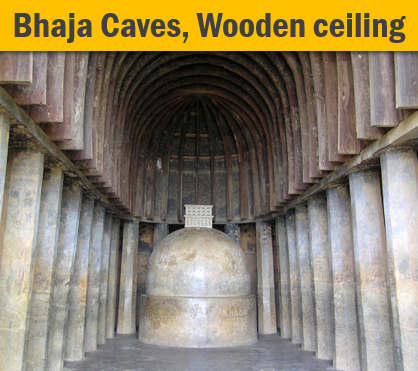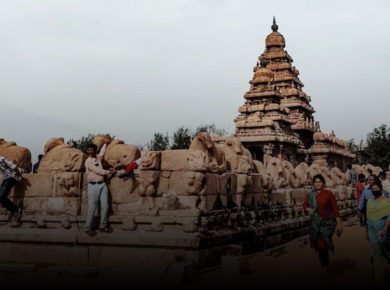Cave Architecture in India (Rock Cut Caves)
Cave architecture in ancient India was a product of the unique socio-religious conditions prevailing in that period. Let’s have a look at the history and evolution of cave architecture in India.
Buddhist Architectural Caves
| Rock cut caves | Ajanta, Kanheri, Karle, Bhaja, Pandavleni |
| Viharas | Residential quarters for Monks |
| Chaityas | Temple + Worship place + assembly halls with a stupa |
| Sangharamas | Buddhist monastery and school |
| Stupas |
|
Karle cave – Lonavala (Pune) – 200 BC
- Carved from the living rock
- Columns are strong and bulky, surmounted by sculptured capitals
- A stupa with a wooden umbrella on top unharmed to this date
- Largest Chaitya-griha among all Buddhist monuments in India
- Has a huge lion pillars in front of Chaitya-griha (only two caves have this design- Karla and Kanheri)
Umbrella is put up to signify that the stupa represented and was built over the ashes of the Lord or his immediate disciples, a sign of royalty and dignity, developed in the course of time an interesting composition on top of the dome, the Harmika; a square Buddhist railing from which rises the shaft that holds the imperial umbrella, sometimes single and later on multiplied to three or even more, diminishing in size as they go upwards.
Kanheri Caves, Mumbai
- Second largest Chaityagriha in India, after Karle caves.
- Lion Pillarsat the Entrance. (Just like Karle caves)
- Podhis: water cisterns for rainwater harvesting
- Images of both Standing Buddha and sitting Buddha flanked by Bodhisattvas
- Famous Satvahan king Gautamiputra Satakarni’s name mentioned in the inscriptions here
- Vihara for resting monks with rock cut seats and benches
Bhaja Caves, Pune
- Hinayana faith
- Has wooden ceiling over Chaitya-griha.
- Stupa has a hole on top, for inserting wooden umbrella
- Verandaha has wooden reliefs showing royal women driving chariots over a demon.
Pandavleni Caves, Nasik
- 24 Buddhist caves belonging to Hinayana Period of Buddhist architecture
- Dating back to the 1st Century CE
- Called as Pandu leni meaning group of caves
- Has nothing to do with the characters of Mahabharata (the Pandavas)
- Inscriptions mention Gautamiputra Satakarni’s mother Gautami Balasri had financed the construction of 3rd cave
- Contains a panel depicting Buddha’s Mahaparinirvana
Ajanta Caves – Aurangabad
- Total 29 caves → Made in two phases viz. 200 – 100 BCE & 5th century CE
- 5 caves are Chaitya-grihas, & rest are Viharas (monasteries)
- Discovered by the British officers while hunting a tiger in 1819 AD.
- Set into the rocky sides of a crescent shaped gorge in the Inhyadri hills of the Sahyadri ranges
- Only surviving example of the paintings of the 1st century BCE and 5th century CE
- Caves are carved on a perpendicular cliff hence no courtyards
- All three forms of Art are combined in these caves: Architecture, Sculpture, Paintings
- Caves depict a large number of incidents from the life of the Buddha (Jataka Tales).
- Were first mentioned by Chinese pilgrim Huen Tsang (He did not visit them though)
- Cave no. 9 and 10 attributed to Satvahan Kings
Fresco Paintings
- A technique of mural painting executed upon freshly laid lime plaster.
- Water is used as the vehicle for the pigment
- With the setting of the plaster; the painting becomes an integral part of the wall.
Fresco Mural Paintings inside Ajanta Cave
Other Prominent Caves Architecture of India
Ellora Caves – Aurangabad
- 5th century CE onwards to 11th century CE
- 34 Buddhist, Bramhanical and Jain caves – Lies on ancient trade route- dakshinpatha
- 12 Buddhist Caves (1-12) + 17 Hindu Caves (13-29) + 5 Jaina Caves (30-34)
- All three forms of Art are combined in these caves: Architecture, Sculpture, Paintings
- unique in terms of stylistic eclecticism, i.e. confluence of many styles at one place
- Buddhist caves having many images belonging to Vajrayana Buddhism
- Buddhist caves are big in size and are of single, double and triple story.
- Ajanta also has the excavated double story caves but at Ellora, the triple story is a unique achievement.
- Ellora cave temples were carved out on the sloping side of the hill. Hence most of the temples have courtyards
- Cave no 16 is a rock cut temple, known as Kailash leni – carved out of a single rock – built by Rashtrakutas
Elephanta Caves – Mumbai
- Originally a Buddhist site which was later dominated by the Shaivite faith
- Contemporary with Ellora timeline i.e. 5th century CE onwards to 11th century CE
- 6thcentury Shiva temple in the Elephanta caves is one of the most exquisitely carved temples in India.
- Sculptures show slenderness in the body, with stark light and dark effects
- Prominent attraction is 20 feet Trimurti showing the three faces of Shiva asAghori, Ardhanarishvara and Mahayogi
- Aghori is the aggressive form of Shiva where he is intent on destruction.
- Ardhanarishvara depicts Lord Shiva as half-man/half-woman signifying the essential unity of the sexes.
- Mahayogi posture symbolises the meditative aspect of the God.
- Trimurti is built deep into a recess and looms up from the darkness to fill the full height of the cave.
- Other sculptures in these caves depict Shiva’s cosmic dance of primordial creation and destruction and his marriage to Parvati.
Mahakali Caves
- Rock-cut Buddhist caves situated in Udayagiri hills, Mumbai.
- Excavated during 200 BC to 600 AD and are now in ruins → Total 19 caves
- Cave 9 is the chief cave and is the oldest and consists of a stupa and figures of Lord Buddha.
Montepzir/Mandapeshwar Cave (Mumbai)
- Probably the only Bramhanical caves to be converted into a Christian shrine
Bagh Caves – Near Gwalior
- Around 6th century CE (Gupta Period)
- 9 sandstone Buddhist Caves with beautiful Frescos and sculptured work
Junagarh Caves (Uparkot – Gujrat)
- Have many interesting Buddhist caves – site of a Buddhist monastery in ancient times.
- Its entrance, in the form of an archway is a fine specimen of Hindu torana




















2 comments
**PLZ correct UNDER MAHAKALI CAVES-
1.It’s in the city of Mumbai.
2. Udayagiri and Khandagiri Caves, formerly called Katak Caves or Cuttack caves, are partly natural and partly artificial caves of archaeological, historical and religious importance near the city of BHUBANESHWAR,ODISHA, India.These are found in Udaygiri Hills. These caves have famous Hathi Gumpa.
superb